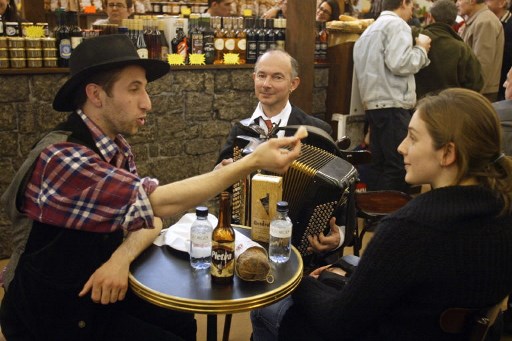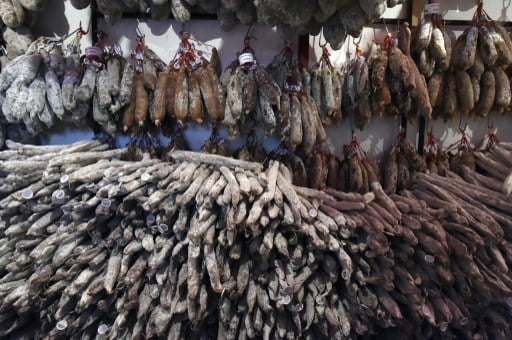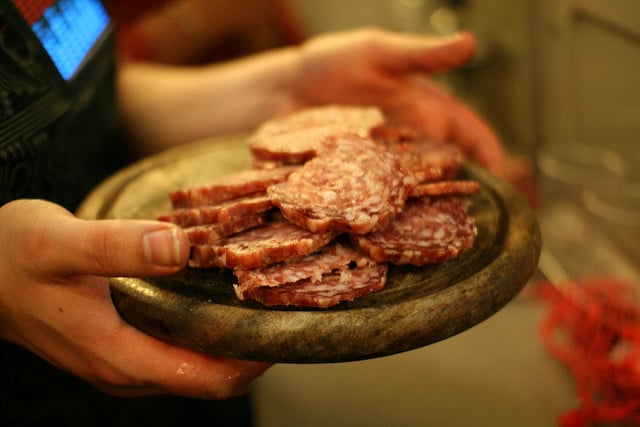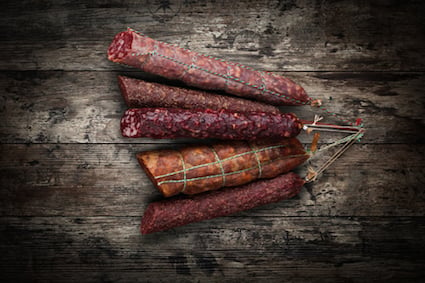It’s official. The first Saucisson World Cup will be held in the tiny village of Vanosc in Ardèche,southern France this June. And who cares?
Well, in a matter of days organizers have received just as many applications to be part of the tasting jury as there are villagers in Vanosc.
“It's going to be chockablock! We’ve received 600 requests from tasters aged 12 to 92,” René-Louis Thomas, head of The Ardèche Academy of Sausage Lovers, told French daily Le Parisien.
France is of course the perfect place to host a Saucisson World Cup given that some 2.2 kilos of saucisson are said to be munched each second in France, which adds up to a total of 70,000 tonnes a year.
So why is it that the saucisson is such a simmering sensation in the hearts and taste buds of people of all ages in France?
Tradition
Saucisson, which gets in name from salsus (salty in Latin) has been made in France since Roman times, with archaeological finds proving so.
According to geography and gastronomy academic Jean-Robert Pitte, cured sausage is a “living historical monument” and a symbol for France since the time of the Great War.
“It was the source of bonding for soldiers in the trenches,” said Pitte about how saucisson would be chopped up and dealt around French troops in WWI. “It was probably the last pleasure for many fallen soldiers.”
For Thomas, saucisson’s symbolism is even older: “It forms part of the traditional Epinal image (19th century illustrations): the beret, the baguette, the Camembert and the sausage”.

Social snack
In the same way as saucisson strengthened the brotherhood between soldiers in the trenches, the tradition of sharing these salty spoils with loved ones and friends lives on to this day.
“For me, the popularity of saucisson stems from its strong association with the apéro (appetizer),” French food writer Clotilde Dusoulier told The Local.
“It’s that special moment at the end of the day when you get together with mates for a drink and some nibbles, to unwind and catch up.
“It feels festive and fun, like a carefree moment taken from a busy day.”

Guilty pleasure
When in 2015 the World Health Organization labeled processed meats like the sauccisson as carcinogenic as smoking and drinking, the reaction in France was nonchalant at best, if not one of complete disdain.
“I survived the war, I’m not going to give up saucisson!”, An 83-year-old Frenchman told The Local at the time.
“I'll stop drinking alcohol and smoking if needs be, but I could never give up meat as it's essential to my diet,” a butcher in the 19th arrondisement added.
And so it is that despite the health warnings from the WHO that eating read meat can cause cancer, the French would rather enjoy the sumptuous salty taste of cured and smoked pork and die with a smile on their faces.
“If it gives you cancer then so be it. I could never live without it,” Maxime, a 21-year-old student in Paris, concluded.

Easy eating
However lazy you’re feeling vis-à-vis preparing something to eat, slicing up some saucisson is as easy as it comes.
There aren’t that many foods either that can be so easily carried around in you pocket or bag without making a complete mess, thanks largely to the natural pig fat wrapping most of them come with.
What’s more, saucisson keeps for ages!
“There are many varieties of saucisson in France because, like cheese, it’s an age-old way to preserve food from the time when there was no refrigeration,” food blogger Clotilde Dusoulier explains.
“Fresh meat goes off but charcuterie like saucisson keeps for months. “

Simply irresistible
Even vegetarians might at times admit to missing the salty, full-flavoured body of cured ham.
Perfected with passion over the centuries, French saucisson is a world on its own.
“Each region independently came up with its own ideas of seasonings depending on what’s available locally in terms of herbs, nuts, etc,” Dusoulier describes.
However many varieties, all saucissons have one thing in common, their ability to calm the most rumbling of bellies, satisfy our protein cravings and on many occasions, be the perfect partner for a lovely glass of wine.

Tomas Hulley/Flickr



 Please whitelist us to continue reading.
Please whitelist us to continue reading.